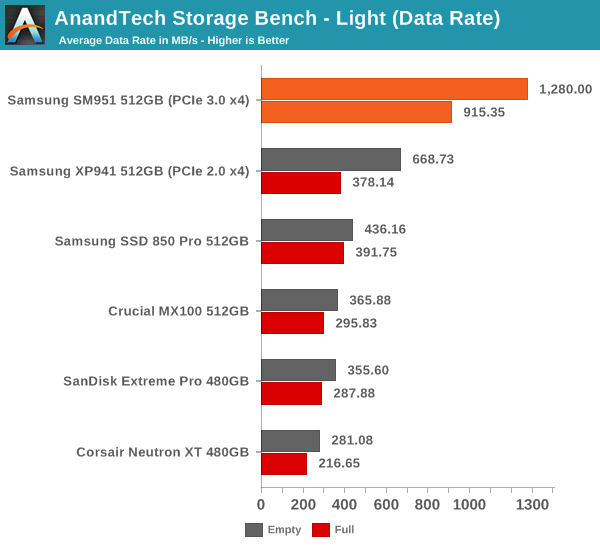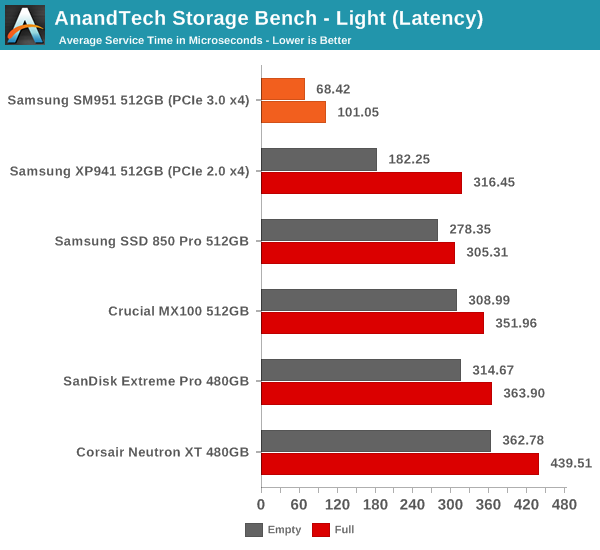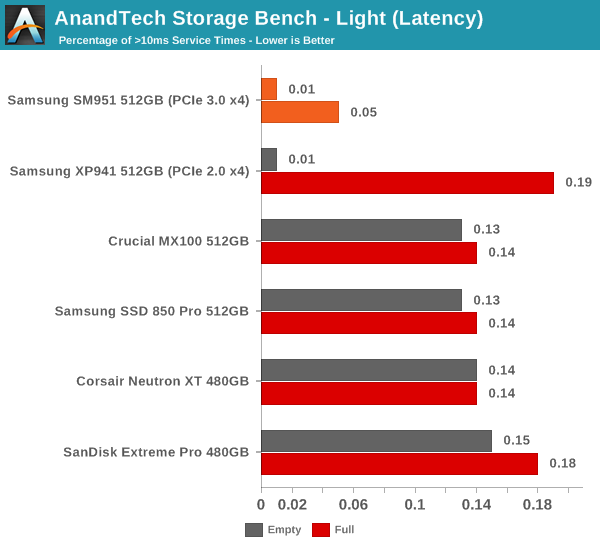Samsung SM951 (512GB) PCIe SSD Review
by Kristian Vättö on February 24, 2015 8:00 AM ESTAnandTech Storage Bench - Light
The Light trace is designed to be an accurate illustration of basic usage. It's basically a subset of the Heavy trace, but we've left out some workloads to reduce the writes and make it more read intensive in general.
| AnandTech Storage Bench - Light - Specs | ||||||||||||
| Reads | 372,630 | |||||||||||
| Writes | 459,709 | |||||||||||
| Total IO Operations | 832,339 | |||||||||||
| Total GB Read | 17.97 GB | |||||||||||
| Total GB Written | 23.25 GB | |||||||||||
| Average Queue Depth | ~4.6 | |||||||||||
| Focus | Basic, light IO usage | |||||||||||
The Light trace still has more writes than reads, but a very light workload would be even more read-centric (think web browsing, document editing, etc). It has about 23GB of writes, which would account for roughly two or three days of average usage (i.e. 7-11GB per day).
| AnandTech Storage Bench - Light - IO Breakdown | |||||||||||
| IO Size | <4KB | 4KB | 8KB | 16KB | 32KB | 64KB | 128KB | ||||
| % of Total | 6.2% | 27.6% | 2.4% | 8.0% | 6.5% | 4.8% | 26.4% | ||||
The IO distribution of the Light trace is very similar to the Heavy trace with slightly more IOs being 128KB. About 70% of the IOs are sequential, though, so that is a major difference compared to the Heavy trace.
| AnandTech Storage Bench - Light - QD Breakdown | ||||||||||||
| Queue Depth | 1 | 2 | 3 | 4-5 | 6-10 | 11-20 | 21-32 | >32 | ||||
| % of Total | 73.4% | 16.8% | 2.6% | 2.3% | 3.1% | 1.5% | 0.2% | 0.2% | ||||
Over 90% of the IOs have a queue depth of one or two, which further proves the importance of low queue depth performance.

The SM951 yet again provides roughly twice the data rate compared to the XP941 and with a full drive the difference is even more significant.

The same goes for average latency where the SM951's score is about one third of the XP941's. The SM951 can without a doubt boost performance with lighter IO loads as well, although in very light workloads the bottleneck tends to be the speed of user input (think about document creation for instance).











128 Comments
View All Comments
Kristian Vättö - Tuesday, February 24, 2015 - link
PCIe adapters are fine for review purposes and are in fact more easily serviceable than M.2 slots tend to be.Samus - Tuesday, February 24, 2015 - link
Thank you for pointing out all capacities are M2 2280 DOUBLE SIDED. That is missing from virtually all reviews, sales material and eCommerce sites for M2 drives. Newegg has been pretty good about taking pictures of both sides of many drives, though.This is important to me because I work with HP Elitebook's and the newest generation of the Elitebook 810 (G2) and 820\1040 all require single-sided. The 840 has room for M2 DS modules, though.
Flash13 - Tuesday, February 24, 2015 - link
The company is not trustworthy! Buy at your own risk. Good Luck.youtard - Tuesday, February 24, 2015 - link
hurr!Wardrop - Tuesday, February 24, 2015 - link
Does this form factor work in standard desktop PCI-e 4x slots?DanNeely - Tuesday, February 24, 2015 - link
It's an m-2 plug, you need an adapter to fit it in a standard pcie slot.wtallis - Wednesday, February 25, 2015 - link
When discussing NVMe, please make it clear that the chipset and motherboard firmware only matter for booting off the drive; they don't need any updates to allow a compatible operating system to access the drive as something other than the boot volume.(As for what the motherboard firmware needs to gain in order to allow booting from NVMe devices, it's just a loadable UEFI device driver. Even if your motherboard doesn't have such a driver built-in, you could load it from some other storage device and then boot off the NVMe drive.)
ericgl21 - Wednesday, February 25, 2015 - link
I wonder if Samsung (or any other OEM) would be willing to sell a 1TB m.2 NVMe PCIe3.0 x4 SSD with SLC NAND with a 2280 form factor?Many professionals would appreciate the speed and reliability that SLC NAND provides.
Sure, it would cost a lot, but so do the Samsung SM951 and Intel P3700.
If that's not possible with current 16nm manufacturing, then a 512GB would also be nice. :-)
Just my 2 cents.
baii9 - Wednesday, February 25, 2015 - link
reliable on nand? Reliable controller matters, high endurance nand matters, I think nand are "reliable' enough already(compare to that lovely controller).IlikeSSD - Wednesday, February 25, 2015 - link
looks like Samsung paid for not showing OCZ in consistency and mixed workload tests )))))